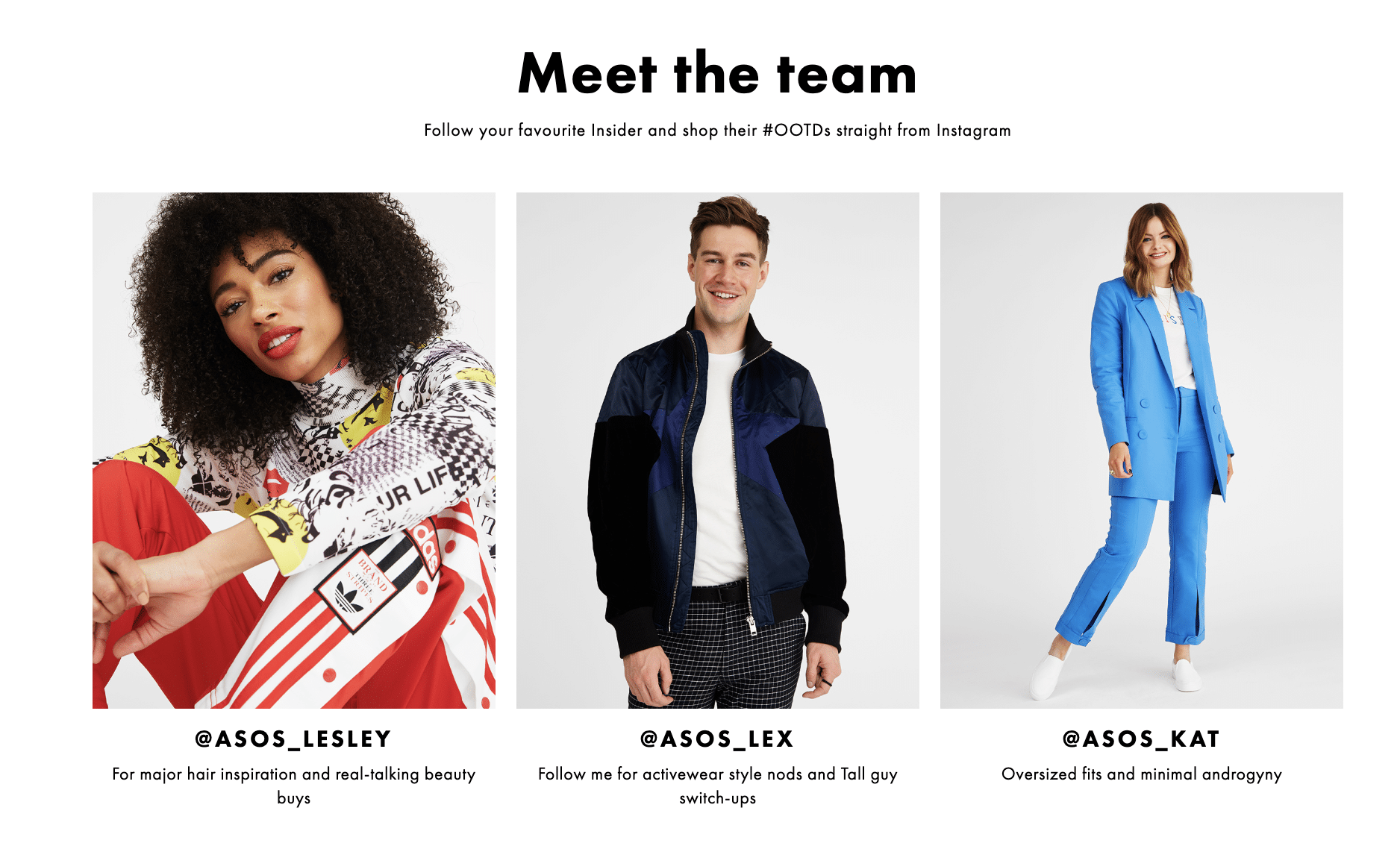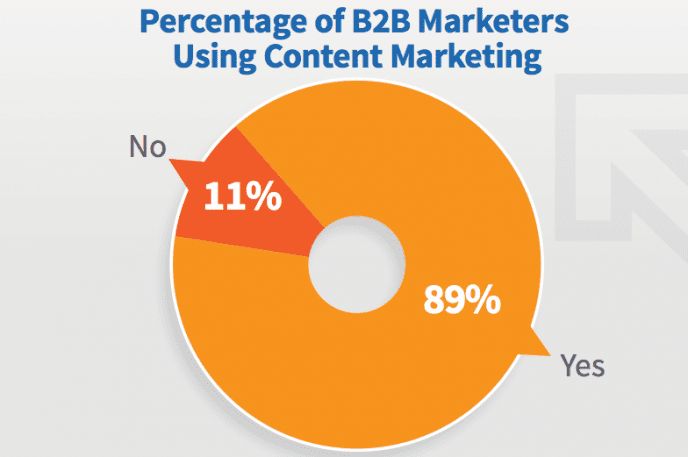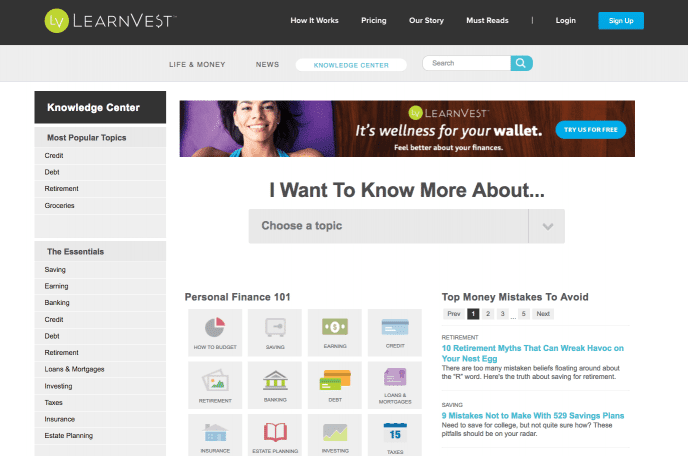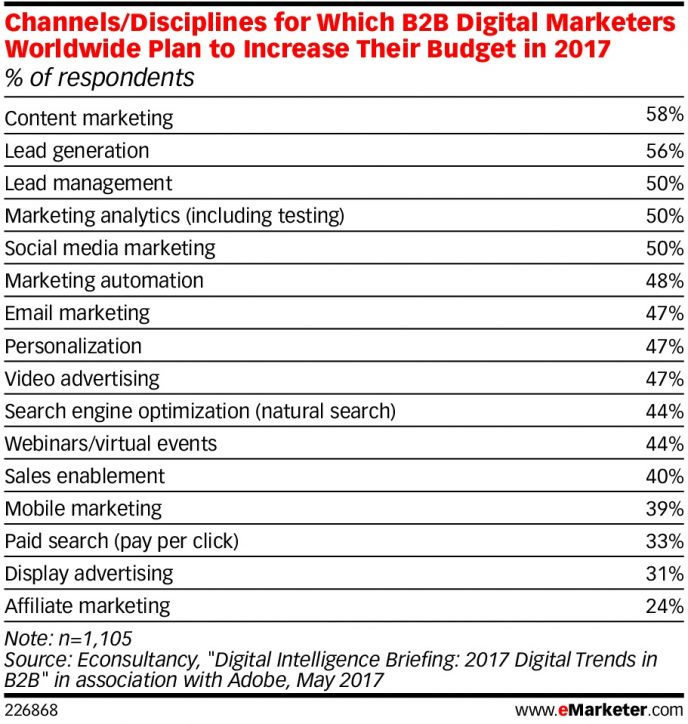Creating content is a great way to market your company, and blogging is big business.
According to the Content Marketing Institute, 89% of B2B marketers are using content marketing, and research by Hubspot proved that the more blog posts a company has published per month, the more traffic they see on their website.
For brands, content refers to any resource used to engage with your audience. It could be an in-depth blog, an eye-catching video, or a shareable infographic.
Content helps your business connect and engage with a growing target audience as you establish your brand as an expert or influencer in your field—but beyond all else, businesses invest in content marketing because it can generate traffic, help drive lead generation and sales, and boost brand awareness.
61% of successful businesses have a documented content marketing strategy (Content Marketing Institute 2017), and you’d be missing out if you’re not taking advantage of this powerful marketing opportunity.
Businesses often fall into the trap of writing about themselves and their product, but alas, long gone are the days of disruptive ads and cheesy sales-like social media posts. Your (target) audience wants valuable, rich and original content (and they want it now).
One of the top challenges marketers face today is that in order to satisfy your audience you must constantly be churning out content. So, how do you continue to produce high-quality content that your audience will discover and enjoy?
The trick here is knowing what your audience wants before you go to the effort to create it. If your niche is carpet cleaning, there’s no point producing content about stargazing.
Creating content for your own niche is smart, simply because you’re already an authority there! Make life easy for yourself and write about what you already know—your audience and customer base will thank you for it.
What is Niche Content?
Niche content is content created to resonate powerfully with a specific audience in order to drive strong results. Niche content can be a great tool for building a better connection with customers, clients, or readers. It can help qualify leads, improve SEO efforts, and it can also help you stand out amongst competitors.
What is Niche Content Strategy?
Before embarking on the creation of niche content, it’s important to establish a niche content strategy. In your niche content strategy, you’ll plan the type of content that makes sense for your audience, and determine how you’ll create and distribute that content to maximize impact. Get to know your audience, create valuable and readable content, and then work on getting it seen.
1. Get to Know Your Audience
Ask Questions
You need to understand what your target audience wants before you take the effort to create it. To really get to know your audience, you’ll want to ask yourself a few questions:
- Why they might be seeking your business at this particular time?
- What are the most common problems your target audience might face?
- How do they currently solve these problems?
- How could your business help solve them better?
In answering these questions with content, you’ll shape the way you interact with your audience. Once inside the mind of your customer, you’ll be able to answer these questions and expand into more topics later on.
Another great way to discover your target audience is to look at businesses similar to yours— competitors can be surprisingly helpful.
Look at their social media pages, and then observe how they communicate with their audience. Study their language and keywords. Their target audience will likely be similar. Studying their content can spark ideas, and help you develop your own communication style.
Create a Persona
Another way to understand your target audience is to create a ‘persona.’ A persona is more than just a demographic or average age, it’s inventing a semi-fictional character that represents a large chunk of your existing audience.
Pick a location, choose their hobbies, decide what social media channel they interact with, what online publications they read, and more. This focuses your content and tailor your tone, style and helps you speak directly to your readers.
Remember; what might be fascinating to you might not be the case for your target audience. Keeping focused on what your audience will want to engage with keeps you on track with your content strategy.
You’ve researched your target audience, discovered who they are, where they spend their free time, and what social media pages they use. Now you need to know how to use it.
The good news is that high-quality content marketing will work—no matter how technical or seemingly boring the niche.
Case Study: LearnVest
A company that’s done a stellar job targeting their audience is LearnVest, a financial services company that offers financial planning to millennials. LearnVest was smart to ask themselves what target their target audience’s problem exactly. What are they facing?
The answer—young adults in America are drowning in debt.
By tapping into millennials, they targeted one of the biggest generations in U.S history, a digital generation that has very different financial habits to their parents before them.
LearnVest has created new financial products that target to this demographic. The result? LearnVest was recently sold for $250 million to Northwestern Mutual.
2. Write Content That’s Easy to Read
Your content shouldn’t read like an academic textbook. Write content that’s easy to read using keywords your audience is likely to use while writing in a relatable way that shows off your personality and displays the people behind your brand.
Keywords do more than just provide an easy read. They also have a huge impact on SEO (Search Engine Optimization)—a way to ensure your content will be found easily, and by the maximum amount of people possible.
The higher the quality and the more original content you produce, the better your content will rank on search engines. Think about what keywords your target audience will search for, and then make sure they appear in your blogs or content.
These are three cardinal rules to creating engaging niche content:
- Stick to short paragraphs and sentences.
- Break up long content with headers, subheaders and attractive images.
- Create concise, eye-catching titles that grab the reader’s attention.
Lists (aka listicles) are another great form of creating content. Lists help readers easily navigate the page and digest the content. Most people don’t read every single word anyway, so write in a way that allows them to scan the important keywords.
Write Original Content
Writing original content is key. Your niche is likely to be overloaded with identical content so why not think out of the box and stand out of the crowd.
Even if you are writing about something that’s been covered extensively, put your own unique spin on it, or talk about your personal experiences.
Your content should be timely and accurate—check your sources, and always ensure you’re giving credit where credit is due.
Keeping your content timely also means refreshing old content. Just because you’ve already posted something, doesn’t mean you can’t go back and give it a new spin. For instance, you could flip a blog post into an easily digestible infographic using great online tools like Canva.
Create Value
Consumers do not want products forced upon them. The best thing you can do to connect with prospects is to create value.
Offer your audience something—whether it be advice, a step-by-step instructional guide, or directing them to helpful resources through links to other articles or white papers. Be actionable by helping them solve a problem, or offer something that benefits them.
When you become an authority, you build trust, and people will keep coming back to your blog as a resource. This works better than overly promotional content—consumers will smell it from a mile away!
Case Study: eCommerce and ASOS
Content marketing works seamlessly in the world of eCommerce, and its importance is steadily growing. With the rise of the digital disruption and an overload of noisy ads, consumers are becoming smarter about who and what they read or listen to.
The hugely popular UK based online fashion retailer ASOS has created a buzz about their brand through their one-of-a-kind content marketing strategy.
Guest bloggers routinely contribute inspiring ASOS’s fast growing audience to live an inspirational fashion lifestyle. It branches out to music, festivals, and international travel, creating a community by using fashion influencers (ASOS Insiders) to feature their products on Instagram. Consumers get to see and view how to wear and incorporate the products into their lifestyle.

Fans are incentivized to shop more and the results speak for themselves. With an overall total of £1,403 million in 2016 for international sales, this company is killing it with content. They currently have more than 4 million followers on Instagram and nearly 5 million on Facebook.
How to get eyeballs on your content
So, you’ve finished creating your content—congrats! The next challenge is getting eyeballs on your post.
Distributing your content through social media channels is a great way to increase visibility and boost shares. After studying your target audience, you will have found where your target audience is present on various social media channels.
If your brand has a strong visual aspect, then Instagram is a great way to distribute your content.
77% of B2B marketers used Twitter to distribute content, and 76% used Facebook in 2017 (Content Marketing Institute).
The number one channel with a whopping 93% of B2B marketers using it as a distribution channel—was email. If you’re trying to reach consumers when they’re open to discovering something new, content discovery platforms like Taboola are the best option for distribution. Native advertising also helps to convert content customers at all stages of the funnel.
To be effective in content distribution, you have to be able to identify those channels and make the most of them. When you have a content distribution plan in place, you won’t need to break your neck making sure your content is seen by the right people.
Effective content marketing begins with quality content. If you’re creating great quality content, your audience will want to engage with your business and eventually pay for services and products you offer.
What’s more, it’s one of the most cost-effective methods to build and promote your brand. Once you’ve figured out where your customers are and really understand what solution they are looking for, you’ll be able to easily provide it for them and create timely, attractive content that ultimately converts.
Taboola is the world’s leading content discovery platform, serving 360B recommendations to over 1B unique visitors each month on the web’s most innovative publisher sites. To learn more about how Taboola can help you A/B test your site content, contact us or start your campaign.





